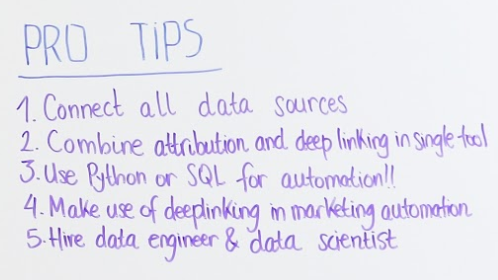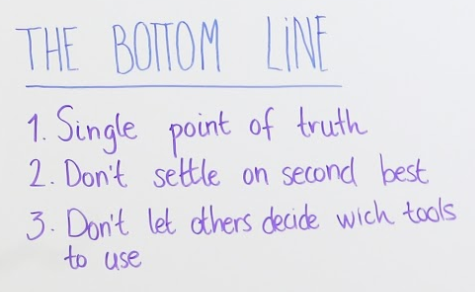
How to build your app marketing tech stack like a pro
Welcome to the fourth edition of MAMA Boards, an AppsFlyer video project featuring leading mobile marketing experts on camera.
For today’s mini whiteboard master class, we have Andre Kempe, CMO of Solidarityapp, a cost-free app demo, download, and donations platform that connects users to app companies and apps to charities.
Andre walks us through the most effective process for strategizing and building a well-rounded app marketing tech stack, and later offers five professional tips for focusing these resources on your company’s most mission-critical goals. Are you prepared to take your marketing tech stack to the next level?
Real experts, real growth. That’s our motto.
Enjoy!
Transcription
Hi, everyone, welcome to another edition of MAMA Boards by AppsFlyer.
My name is Andre Kempe, CMO of Solidarityapp. We are a new platform that creates tools for content creators like Twitch streamers, YouTubers, and Instagrammers to not only engage with their audiences but also to collect free donations through app downloads.
I have worked in UA since ringtones were a thing and since then, I’ve worked in a lot of companies like Zalando, LOVOO, Trademob and many others. I’ve seen a lot of things when it comes to app analytics and this is why I will talk you through the exciting exercise of “How to Build Your App Marketing Tech Stack Like a Pro” today.
This is actually inspired by the famous Mobile Growth Stack from Andy Carvell, but obviously it’s a little bit more steered towards the analytical side of things. Let’s get started.
Why is having an established marketing tech stack important?
Why do you need this app marketing tech stack in the end?
At the very beginning, you might want to start a company with just one or two people, you’re releasing your app, you are super happy that you’re getting your first downloads. You might even look into iTunes, Google Play, and those kind of platforms for publication.
However, as soon as you start scaling and have more people onboard, you will want to inform different stockholders and you might need to gather data for investors. You will probably also need a more sophisticated analysis of what your users do within your app, how you are getting your users, what you are paying for users, and so on.
This is why you will need to build a robust architecture to understand how your users are getting onboard with your app and how they are behaving after re-engagement. You will need this tech stack to structure your data processing and understand the behavior of your users.
Getting started with the attribution part of things, in the very beginning, you’re probably just focusing on the iTunes stuff and trying to understand that the users are coming from certain channels.
The problem is that you might not really understand, when you start investing money, if the users that are coming from, for example, Instagram, are actually paid users or organic users. That’s the moment when you consider implementing an MMP SDK to understand if the money that you invested brings those users that you need who are engaging with your app.
What elements should I include in a well-rounded app marketing stack?
Mobile attribution
That’s why the first thing in an app marketing tech stack is obviously mobile attribution – you want to know where your users are coming from and how they behave afterwards. You want to pinpoint your top growth & re-engagement sources and want to see not only how people download the app, but also how they behave right after the download or even when they got re-engaged through a push notification or an email, for example.
You want to connect all your buying sources, all your media sources with a universal SDK, you don’t want to have a thousand SDKs inside from different partners, right? This will just make your app more complex and heavy for the users to download.
You want to have, also, a single point of truth from one unbiased partner so that all the media partners you’re working with also trust the results that you’re sharing with them. You want to measure across the funnel, not only from the acquisition side of things but also, as I already said, similar to after the re-engagement communication part, how the users are behaving, how they are moving forward in the purchase funnel, for example, or how are they moving from one level to the next level when we talk about a game.
When we solve the attribution thing, we are talking about re-engagement, in which you have acquired users and paid a lot of money for them on Facebook, AdWords, and maybe some random other channels. You want to talk about deep linking them back to the point where they actually broke or stopped purchasing the latest added issue or doing an in-app purchase for 999 diamonds for your game, for example.
Basically, you want to bring them back into your app.
Marketing automation
For this, you will also need something like marketing automation that helps you to communicate with the users right after they dropped off in the conversion funnel.
For marketing automation, there are a lot of tools out there that you can use, which will help you to send a push notification – for example, Firebase.
There are other tools – for example, MailChimp – which help you to send emails to your users. The problem with that is that you can’t integrate all that information together very easily. This means that you can’t easily build an audience or segmentation. You shouldn’t be able to say, “This user has clicked a particular email with one special topic and then the same user gets exactly the same push notification with the same message with the two campaigns living in different tools” – you want to avoid this.
Therefore, you want to make a decision aiming towards marketing automation tools that bring all those features together – consider push notifications, in-app messages, maybe even web push notifications and emails. You want to be able to build a funnel across all communication channels.
Deep linking
Once you are communicating with the users, as I said, you will need a deep linking functionality.
The problem with deep linking functionality is that, if you use it from a different provider than your attribution platform, you, again, have the problem of tying this data together and understanding where the users are dropping off and how are they behaving.
One recommendation I can give is to put deep linking and attribution together in one SDK with one well-selected MMP.
In-app analytics
Now let’s talk about in-app analytics for a moment. Usually, this is something product managers work with very deeply. They use these metrics to identify problems within the app and to see if a certain screen is useless or helpful, or if they should move a button from the top left to the bottom right – these kind of optimizations.
Us marketers and UA managers, on the other hand, might also want to understand where the users drop off in the conversion funnel because we are very ROI driven, aren’t we? In-app analytics are something that helps you to segment your audience to identify the re-engagement groups, which you then can use in your marketing automation tools.
I highly recommend taking a deep look into in-app analytics. I can give you an example. In the past, when I was working for an eCommerce company, I did a big promotion to advertise the newest Adidas or Nike shoe or something like that, including a massive coupon discount that I could offer to my audience. The problem was that, after I got them into the app, while they were super excited and [expressed intent] to buy, they didn’t convert in the end. That meant that the conversion rate was quite low and the ROI wasn’t really happening.
So, I had bad results as a marketer.
The product manager had shipped his app, saw that the screen was working from his perspective and that conversion rates were somehow happening, but I as a marketer was very quickly able to identify that there was a problem somewhere.
At that point, I needed to look into the in-app analytics and was eventually able to tell someone, “Hey, there is something broken in the purchase functionality, the entering function for the coupon code wasn’t available.” What had happened was that I had brought users into the app, but they literally weren’t able to purchase at the discount rate I was offering.
These are things you can only see when you, as a marketer, are really using granular level in-app analytics tool and not only your product manager, who might not even be informed about your advertising campaigns, like this particular coupon for this particular shoe in this particular country.
App store intelligence
Let’s talk about App Store Intelligence for a moment.
This is something very different from regular attribution. App Store Intelligence helps you as a marketer understand how you are positioning your app in the app stores. You want to understand how your competitors are doing in certain countries, how you are doing in the same countries, if there is maybe a niche somewhere out there that you are missing, etc.
You will also be able to understand which keywords are important for you, or if there is maybe a keyword that you are not using right now in your description on the app store [to optimize organic discovery].
As another of my own examples, when I was working – consulting, actually – for a food delivery app, I was going through the description title and other parts of the app’s app store profile and I quickly identified we weren’t getting found by the keyword “pizza,” which is obviously super important for a food delivery app.
What I then figured out was that it was simply missing in the description. The first key lesson I learned there was that I was able to use an app store intelligence tool to optimize very basic things to position my app in the app store and have the advantage over my competition.
Backend integration
Now that you understand how your attribution works, how your email campaigns work, and how your deep linking works, you will already be analyzing a lot of data, right? You might also ask yourself, “Why the hell do I need a backend integration or a data warehouse integration, whatever you call it?”
Well, let me give you one example.
You might have an SDK from your MMP integrated, and be measuring purchase events and revenue streams – this information is all there. However, since we are all human, with every app update, something can happen, like a bad documentation or a developer who broke something in the code, and you are suddenly losing information in your measurement efforts.
The same can happen in your data warehouse, where your company may be storing all the information about original orders along with credit card information or any other information that your company is storing about your customers.
Needless to say, developers on both sides can break things and having a backend integration in your app marketing tech stack will enable you to quickly identify flaws in your data. You will quickly be able to see issues in real-time. If, for example, you’re running 16 country campaigns in parallel, you might be able to spot that in, let’s say Germany, there is something broken, but in all other countries, the campaign is perfectly running.
So, there are certain reasons why you want to have a backend integration to combine all the data together and see differences in the different systems.
Business intelligence (BI)
This brings me to business intelligence, the BI tools that are very famous right now.
You might have started with Excel files, you might have used Google Sheets or other tools that are freely available and easy to handle for most of us, you might be able to draw your Pivot charts and so on, but as soon as you have a running, scaling business that is using a lot of raw data from many different systems, those tools don’t work anymore.
You will need a tool like Tableau, ClickView, Data Studio, or others to combine all the data and build your custom dashboards for all the different stakeholders in the company that might look from a different angle on your business and want to understand what’s happening in the context, let’s say. That’s why these business intelligence tools are very important for growing businesses since you can quickly see the success of your app or your company.
5 pro tips

Now that we’ve learned a lot about the app marketing tech stack, let me summarize all this for you in my pro tips.
First, connect all data sources. Why do you want to connect all data sources? Well, you want to identify patterns and see things happening in different countries, for example.
Pretend your competitor in Austria is ranking very well in the app store and that you are therefore missing an opportunity there. You will easily be able to see the why behind his higher ranking in Austria when you connect all data sources and understand that your app marketing spend on Facebook, Google AdWords, and other channels in Austria is very low or your actual success ratio is very low, etc.
Second, combine attribution and deep linking in a single tool. In this case, attribution is actually the specialty and deep linking is the commodity. The selection of the right attribution partner is super important because all of your media sources, all of your buying partners, need to trust both your MMP and the data that you’re sharing with them. The same applies to the deep linking functionality itself – you ultimately want to understand data patterns within one dashboard.
Third, use Python or SQL for automation.
[Even if this is] maybe something that everyone is aware of, [the reality still remains that many marketers still input their data manually]. When you get to the office every day at 9 AM, open your Google Sheets or your Excel file, and start copy pasting cost information from Facebook or [your other marketing tools] into a single data sheet to display it in the BI, this can be very frustrating. [Not only that, but] it is a source of human error and you probably waste a lot of time.
You can automate that process. In order to automate those things, you can use a few certain scripts. Just ask your in-house developer, or hire a freelancer, to program these scripts to connect to API’s and pull all that data automatically without the human error interface.
Fourth, make use of deeplinking and marketing automation. This is super important. Marketing automation is probably the most useful and cost-effective channel that you will ever have – not even Facebook will be able to compete with that. Emails, push notifications, in-app messages, even web push notifications, have been and will continue to be the tools to use to engage with your audience and bring them back into your app. So, make use of them and try to personalize your communication as much as possible.
Fifth and finally, if you are able and if you are growing, as soon as you can, hire a date engineer and a data scientist. The data engineer will help you structure your data, while the data scientist will actually help you understand and interpret the data. He will see other patterns than those you have, and he has the mathematical background to interpret the numbers better than you as a regular marketer who might have studied marketing and focused on the digital side of things.
Key takeaways

So, let’s come to the bottom line.
One, you will need to choose your single point of truth. For me personally, when it comes to data analysis, my single point of truth is primarily the MMP. For most marketers I’ve spoken with, it’s always the same decision – it’s typically the MMP. Obviously, there are debates about this in the industry some times when other people say, “Yeah, but my backend, my data warehouse, is my one single point of truth.”
Ultimately, there is no right or wrong, it’s totally your decision, but you have to commit to that decision. Never mix data up and never look from different angles when you actually need to understand what’s happening in your business.
Two, never settle on the second best. This applies to all tools that I mentioned here – never choose the one that comes at the lowest price point or is even free. I can absolutely and highly recommend investing the time to understand the features and the functionality of each tool that you choose.
For example, considering marketing automation, try to find a tool that is as flexible as possible, that enables you to create audiences and segments and automize communication channels that you shouldn’t want to manage manually. So, never settle on the second best.
Three, and most importantly, never let anyone else decide which tool(s) you use. Try to involve yourself as early as possible in the decision making process because it will save you a lot of time. Once you have decided and especially once a tool has been implemented, it is super hard to roll back or find another tool for implementation.
So, this decision is super important and it’s very necessary that you involve yourself very early in the decision making process.
Well, that’s it. Thank you very much for watching!
If you have another opinion than me or if you want to say something additionally, post it in the comments.
Thanks from my side!
Bye bye.




